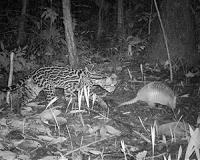 |
Brisbane, Australia (UPI) Feb 28, 2011 Australian researchers say they are looking at a range of engineering ideas to protect endangered amphibians from the effects of climate change. Scientists say amphibians are particularly vulnerable to changes in habitat and temperature ranges, with many species also having a very limited distribution, the BBC reported Monday. "One of the things that has dominated research, certainly as far as climate change is concerned, is impacts," Luke Shoo from the University of Queensland says. "I think we are getting to a stage where a lot of managers and researchers are demanding some sort of solution." The life cycle of amphibians makes for a tough upbringing, Shoo says. "They have to deal with an aquatic life-stage, and also have a terrestrial adult stage," he says. "So you need an environment where you can get the eggs and the tadpoles, then you have to have to have an environment that allows them to survive physiologically as adults." One proposed solutions is to create "micro-habitat shelters" by having forestry operators leave a pile of dead wood, rather than clearing an entire area, to protect amphibians from drying out and from temperature stress. There is precedent for this kind of management intervention in conservation, Shoo says. For example, to encourage healthy reptile populations scientists have gone into overgrown areas and reduced the forest canopy to allow more of the warmth from the sun to reach the ground. "Essentially, we will be doing this in reverse," Shoo says. "We will be sheltering and reducing exposure in order to protect amphibians."
Share This Article With Planet Earth
Related Links Darwin Today At TerraDaily.com
 Candid Cameras Give A Chance To See Wildlife As A Scientist Does
Candid Cameras Give A Chance To See Wildlife As A Scientist DoesBoston MA (SPX) Feb 28, 2011 The new website allows the public to see exactly what scientists see in their research-photos of wildlife captured at close range, from the head-on stare of a jaguar in Peru to inside the mouth of a giant panda in China. "This site provides the public a glimpse of what the scientist sees when surveying remote places," said William McShea, research wildlife biologist at the Smithsonian Cons ... read more |
|
| The content herein, unless otherwise known to be public domain, are Copyright 1995-2010 - SpaceDaily. AFP and UPI Wire Stories are copyright Agence France-Presse and United Press International. ESA Portal Reports are copyright European Space Agency. All NASA sourced material is public domain. Additional copyrights may apply in whole or part to other bona fide parties. Advertising does not imply endorsement,agreement or approval of any opinions, statements or information provided by SpaceDaily on any Web page published or hosted by SpaceDaily. Privacy Statement |